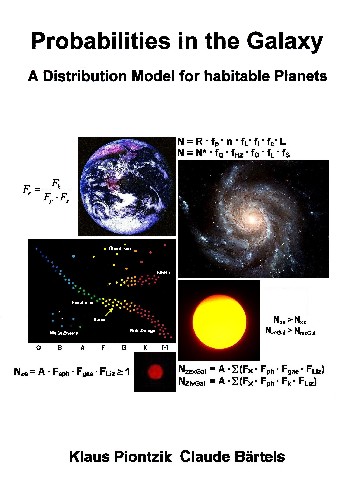 |
The Seager
equation treats only the red dwarfs, that is, a
certain set of stars, the so-called M-stars. One
can extend the consideration here and also refer
to other sets of stars, e.g. On the G-stars the
sun-like stars.
The Seager equation is then compatible with
Equation System 6.3.3 and can be completely
replaced by the relationships found in Chapters
1-7. |
N* = Ns
= A·Fs according to
Equation 1.4.1, for the number of G stars (sun-like
stars) present in the galaxy with Fs
= 7:25 and A = 100-300 billion
stars.
fQ G-stars
do not throw gamma rays into space, so all stars are
observable, ie fQ =1. The factor can therefore
be dispensed with.
fHZ
= Fph = Fp·Fh
is the proportion of those G stars, which
have a planet first, and secondly it is in a habitable
zone. Fp =
201:14,000 and Fh
= 10:603.
fO =
Fk quantifies the
proportion of those planets which visibly travel past the
star for the Kepler telescope. According to Chapter 1.2,
the probability of such a transit is 0.47 % so Fk
= 0.004,7.
fL =
FL is the fraction
of planets with life, with FL
= 1:9.
fS stands
for an intelligence which leaves a measurable
biosignature in the atmosphere, ie a technological
civilization, with fS
= Fi·Fz
= 1:14 · 1:7,943 = 1:111.203
The entire Seager equation can then be applied to the set
of solar-like star systems in the galaxy observed with
the Kepler telescope (or equivalent). All the probability
factors of the Seager-equation are completely replaceable
by the factors from the equation system 6.3.3. The
transformed Seager equation for G stars is then:
| 10.3.1 Equation |
N = A · Fs
· Fp ·
Fh
· Fk ·
FL ·
Fi
· Fz |
According to definition 1.7.1 is Fsph = Fs
· Fp · Fh = 1:15,000
According to definition 6.2.2 is: FLiz = FL
· Fi · Fz = 1:987
Equation 10.3.1 can thus also be written as transformed
Seager-Equation:
| 10.3.2 Equation |
N = A · Fsph
· Fk ·
FLiz |
Substituting
all the values into equation 10.3.2:
N = (100-300)·109 · 1:15,000 · 0.004,7 ·
1:1001
N = 32 – 94 technological civilizations
Comparison of special basic model
Equivalent and thus comparable to the
transformed Seager equation is equation 6.3.3 from the
Special Basic Model. According to theorem 6.4.1 of the
Special Basic Model, there are probably 10 - 290
technological civilizations, on "Earth 2" in
solar-like systems, in our galaxy.
The Drake Seager window is well located in the lower part
of the basic model window. The Drake-corrected Special
Basic Model 9.8.2 delivers 22 - 199
"Earths 2" with technological civilizations.
The Seager_window is well located in the lower part of
the Drake window.
| 10.3.3 Theorem |
The special basic model and
the transformed Seager equation represent two
mutually equivalent approaches. |
In the Seager approach, earth-similarity plays no
role and only technological civilizations, on habitable
planets in the galaxy, are asked.
This model can also be transferred to other star sets and
observation devices. If you omit the factor Fz,
then you can apply equation 10.3.2 to intelligent
species. If you omit the factor Fi, then
equation 10.3.2 can also be applied to animate planets.
|
